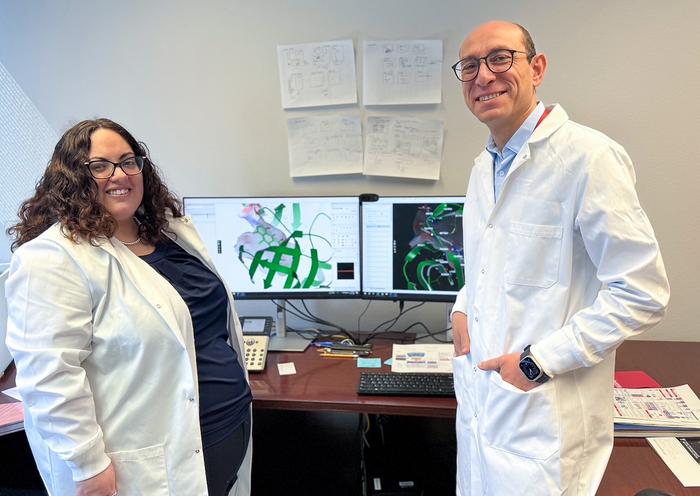Chronic pain management has long been dominated by opioid analgesics, yet the escalating overdose crisis highlights the urgent necessity for alternative therapies. In the United States alone, opioid-related fatalities exceeded 107,000 deaths between December 2020 and December 2021, underscoring a devastating public health emergency. Against this backdrop, groundbreaking research led by Dr. Mahmoud Salama Ahmed and Dr. Jenny Wilkerson at Texas Tech University Health Sciences Center (TTUHSC) is pioneering non-opioid approaches aimed at chronic neuropathic pain, with support from a recently awarded $1.94 million, five-year grant from the National Institute of Neurological Disorders and Stroke (NINDS).
Dr. Ahmed, a distinguished pharmaceutical scientist at TTUHSC’s Jerry H. Hodge School of Pharmacy, directs a project focusing on selective inhibition of EphB1/2 tyrosine kinase domains—key molecular components implicated in peripheral neuropathic pain signaling. Prior studies from Ahmed’s lab have demonstrated the potential of certain tetracycline antibiotics to reverse hallmark pain symptoms such as thermal hyperalgesia and mechanical allodynia, but high effective doses and antibiotic resistance concerns limit their therapeutic viability. Elevating this research, the new initiative seeks to design small molecule inhibitors structurally distinct from conventional tetracyclines, aiming to enhance potency and selectivity with fewer side effects.
At the molecular level, EphB1 and EphB2 belong to a family of receptor tyrosine kinases crucial for cell-cell communication, synaptic plasticity, and nociceptive signal transduction. Nerve injury often induces aberrant activation of these kinases, leading to enhanced neuronal excitability and the chronic manifestation of neuropathic pain—a complex sensory disorder marked by abnormal pain responses to normally non-painful stimuli. Dr. Ahmed’s approach leverages insights gained from resolving the crystal structure of tetracycline binding pockets within the EphB1 domain, providing a scaffold to rationally design inhibitors that disrupt this pathological signaling axis more efficiently.
Despite promising initial results demonstrating competitive inhibition of EphB1 by tetracyclines, effective dosages in the low micromolar range raise translational hurdles; such concentrations carry risks of off-target effects and antimicrobial resistance. Recognizing these limitations, Ahmed’s team embarked on extensive structure-activity relationship studies, synthesizing over 50 candidate molecules featuring novel chemical backbones optimized for improved binding affinity and kinase selectivity. Early pharmacological profiling suggests that two front-runner compounds show substantial efficacy in preclinical models, reversing key neuropathic pain phenotypes without antibiotic activity.
Crucially, the research involves a collaborative, multidisciplinary effort with Dr. Jenny Wilkerson, whose expertise in neuroimmune mechanisms enriches the translational scope of the project. Wilkerson’s laboratory brings 17 years of experience dissecting immune contributions to chronic neuropathic pain, enabling rigorous evaluation of these novel inhibitors in vivo. Her team assesses not only the analgesic potency but also the safety profile, monitoring possible neurobehavioral side effects to ensure therapeutic doses maintain functional integrity and cognitive health in animal models.
The partnership between Ahmed and Wilkerson embodies a sophisticated bench-to-bedside framework, utilizing biochemical validation to inform molecular design, followed by behavioral assays that closely mimic human neuropathic conditions. Their integrative strategy is poised to address the dual challenges of efficacy and safety—long-standing obstacles in neuropathic pain drug development. By potentially preventing the onset or reversing established chronic pain states, these EphB1/2 kinase inhibitors could redefine the pharmacological landscape beyond opioids and gabapentinoids, which frequently fail to provide comprehensive relief.
Beyond therapeutic innovation, the implications extend into basic neuroscience, as selective kinase inhibition tools could unravel the intricate signaling networks governing neuronal activation and nerve injury responses. Dr. Ahmed posits that these compounds may serve as molecular probes to elucidate how EphB receptor pathways modulate neuroplasticity and immune cell interactions during chronic pain syndromes. Such mechanistic insights could illuminate new biomarker targets and inform personalized pain management strategies.
Meanwhile, rigorous preclinical evaluations continue, with ongoing assessments of pharmacokinetics, bioavailability, and long-term impact in model systems. The developers emphasize that translating these findings to clinical use will require thorough validation across various neuropathic pain etiologies, including diabetic neuropathy, chemotherapy-induced peripheral neuropathy, and traumatic nerve injuries. Should these agents prove effective in modulating pathological kinase activity without untoward effects, they could fill a critical gap in non-addictive chronic pain therapeutics.
As the field awaits further data, this project highlights how innovative drug discovery grounded in molecular pharmacology is reinvigorating approaches to one of medicine’s most vexing challenges. The confluence of structural biology, pharmacochemistry, and neuroimmune science embodied by this work exemplifies the contemporary paradigm for addressing complex disorders through targeted molecular interventions. More broadly, it demonstrates a promising path forward in reversing the devastating impact of opioid dependency on public health.
Dr. Wilkerson expresses optimism about the larger clinical potential: “Our ability to prevent the development of chronic pain through precise molecular inhibition represents a landmark shift. Many current treatments are reactive, addressing symptoms without altering disease progression. This project strives to change that trajectory.” Meanwhile, Dr. Ahmed adds, “Our goal is to pharmacologically validate EphB1/2 tyrosine kinase inhibition as both necessary and sufficient to attenuate peripheral neuropathic pain, potentially setting a new standard for pain management.”
Ongoing experiments will help delineate therapeutic windows and optimize dosing regimens to maximize efficacy while minimizing any adverse neurobehavioral effects. If successful, these novel EphB1/2 inhibitors may form the foundation of a new class of targeted analgesics that could alleviate suffering for millions worldwide, reducing reliance on opioids and mitigating the epidemic of addiction and overdose.
Subject of Research: Development of novel, non-opioid EphB1/2 tyrosine kinase inhibitors for peripheral neuropathic pain management
Article Title: Innovative Small Molecule EphB1/2 Kinase Inhibitors Offer Hope for Non-Addictive Neuropathic Pain Therapy
News Publication Date: Not specified
Web References: Not specified
References: Not specified
Image Credits: TTUHSC
Keywords: Neuropathic pain, Tyrosine kinase inhibitors, EphB1/2 kinase, Chronic pain, Peripheral neuropathy, Small molecule inhibitors, Thermal hyperalgesia, Mechanical allodynia, Pharmacological inhibitors, Neuroimmune mechanisms, Drug development, Non-opioid analgesics




